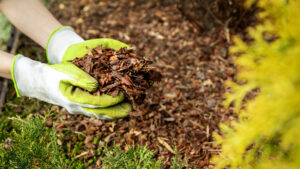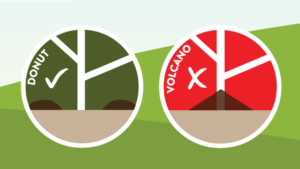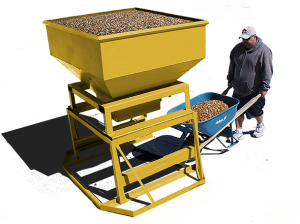By: Anna Stubbendick, FCHP
Mulching is an essential aspect of gardening in Florida. It provides numerous benefits, such as retaining moisture, suppressing weeds, regulating soil temperature, and improving soil health.

Mulching plant beds is essential in Florida. The most common varieties of natural mulches are pine bark, pine straw, and shredded blends which come in a variety of colors such as natural, red, black, and brown.
Mulching is one of the principles of Florida-Friendly Landscaping, a set of guidelines designed by the University of Florida IFAS Extension to promote sustainable landscaping practices in Florida. By using mulch, you can reduce water consumption, limit the use of chemical fertilizers, and minimize yard waste. Florida-Friendly Landscaping emphasizes the use of mulch made from natural, locally-sourced materials, which helps support local businesses and reduces the carbon footprint associated with transportation. By incorporating mulch into your landscaping practices, you can create a beautiful and healthy outdoor space while minimizing your impact on the environment.
(Learn more about the Nine Principles of Florida-Friendly Landscaping)
Here are some mulching tips to help you get started:
- Choose the right mulch: There are many types of mulch to choose from, such as wood chips, pine straw, and shredded leaves. Consider the purpose of your mulch, the plants you’re mulching, and the aesthetics you want to achieve.
- Apply the right amount: A good rule of thumb is to apply 2-3 inches of mulch around your plants. Too little mulch won’t provide enough coverage, while too much can suffocate your plants and promote fungal growth.
-

One of the most common examples of incorrect mulching is “volcano mulching,” in which excessive amounts of mulch materials are applied at the base of plants and piles against the trunks or stems, creating a volcano shape. Mulch should not touch the stem or trunk of your plant and doing so can lead to improper root growth, decay, and infestation.
Don’t pile mulch against plant stems: Mulch piled against the stems of plants can trap moisture and promote rot. Keep a few inches of space between the mulch and the stems of your plants.
- Mulch regularly: Mulch breaks down over time, so you’ll need to add more to maintain the desired depth. Aim to mulch at least once a year or as needed.
- Use mulch as a soil amendment: As mulch breaks down, it adds organic matter to the soil, improving soil health and fertility. When adding mulch, consider using it as a soil amendment instead of just a top dressing.
- Consider the time of year: In Florida, the best time to mulch is in the spring or fall when temperatures are moderate. Avoid mulching in the summer when the heat can trap too much moisture around plant roots.
(Pro tip: Be careful if using some of the free recycled mulches that may be available from tree services or municipal debris collection sites. These mulches are not treated or certified in any way and can often contain debris that has many seeds for weeds just waiting to sprout in your beautiful plant beds.)
While organic mulches like wood chips, pine straw, and shredded leaves are popular choices for mulching, there are also alternatives such as stone or rubber mulch. Here are some pros and cons to consider before choosing an alternative mulch:
Pros:
- Long-lasting: Stone and rubber mulch can last for years without needing replacement.
- Aesthetically pleasing: Stone mulch can give a garden a clean, modern look.
- Eco-friendly: Rubber mulch is made from recycled materials.
- Does not attract pests: Unlike organic mulches, stone and rubber mulch do not attract pests such as termites or rodents.
- Provides good drainage: Both stone and rubber mulch allow water to easily flow through them, preventing waterlogging and root rot.
Cons:
- Expense: Stone and rubber mulch are usually much more expensive than organic mulches.
- Can retain heat: Both stone and rubber mulch can absorb and retain heat, potentially overheating plant roots and damaging plants during hot weather.
- Does not improve soil health: Unlike organic mulches, stone or rubber mulch do not break down and improve soil health over time.
- May contain harmful chemicals: Some rubber mulch products may contain harmful chemicals that can leach into the soil and harm plants.
- Availability: Rubber mulch has become less available in recent years due to some of it’s negative characteristics, so it may be difficult to find. Some of the stone blends have also been less available in recent times due to the general supply-chain issues affecting availability of all items, but that seems to be less and less of an issue as time goes on.
-

The Drop N Rock was designed to make working with rock a little easier.
Weight: Stone is significantly heavier than both natural and rubber mulches, which can present difficulties for those with physical limitations. (Pro tip: If you’re looking to DIY stone in your plant beds, consider purchasing from Rock Solid Stone Center in the Tampa Bay area. They offer the rental of a device called the “Drop N Rock” hopper, which allows you to move and install aggregate without shoveling and without the mess.)
Ultimately, the choice of mulch comes down to personal preference, the needs of your garden, and your budget. Consider the pros and cons of each option before making a decision, and don’t hesitate to ask our garden center experts for advice.

